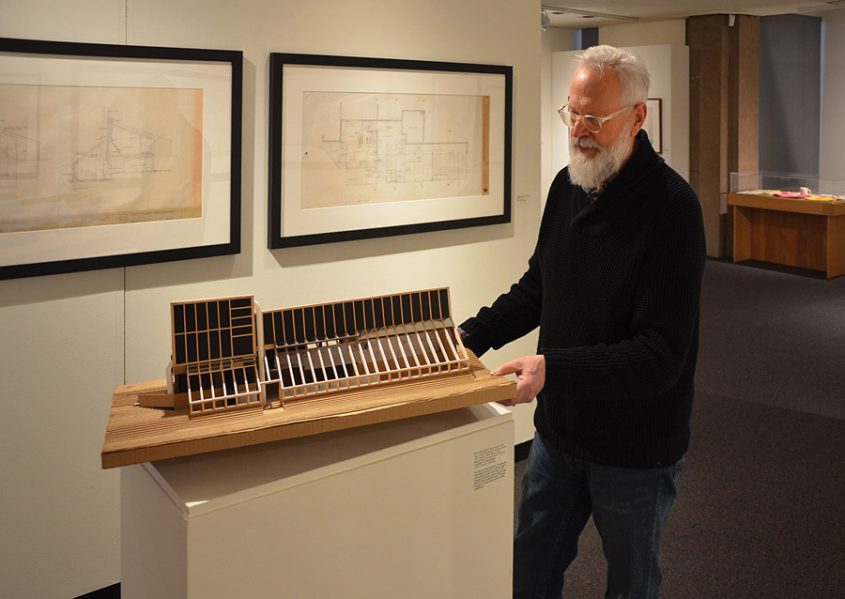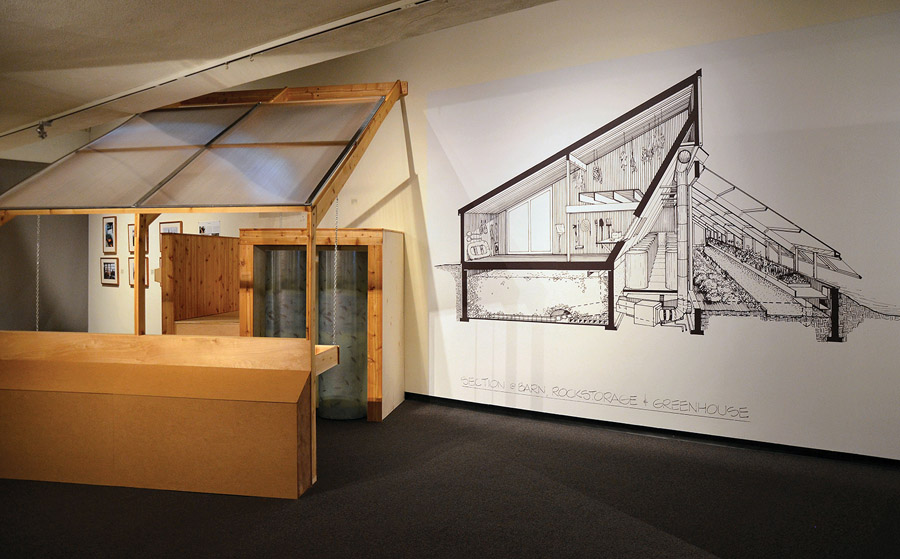Exhibition Review: Living Lightly on the Earth

TEXT John Leroux
Prince Edward Island’ s two most iconic works of modern architecture couldn’t be more different. But at this moment, the brutalist stone-clad Confederation Centre of the Arts in downtown Charlottetown and the earthy wood-framed PEI Ark at Spry Point are intimately connected. The Confederation Centre is currently hosting an exceptional exhibition revisiting the Ark—a mid-1970s bioshelter, and one of Canada’ s most admirable exercises in fusing visionary environmental stewardship with viable building and living practices.
Both the Confederation Centre and the Ark were lauded projects at their respective openings. Their differences in sensibility show how far social and political attitudes had shifted in the decade between the heady days leading up to Canada’ s Centennial, and the mid-1970s, when environmental awareness and the aftershocks of the energy crisis were paramount.

The “back to the land” movement of the 1970s and its DIY attitude of building simply, using local technologies, helped make the Ark a focus of national attention. Officially opened in 1976, the Ark was the brainchild of the New England-based New Alchemy Institute, an ecological research centre. Its design was shaped by Solsearch Architects (now BGHJ Architects) a partnership of young architects David Bergmark, FRAIC and Ole Hammarlund, both of whom moved to PEI from the northeastern United States to work on the project. Bergmark and Hammarlund saw the Ark as “ an early exploration in weaving together the sun, wind, biology and architecture for the benefit of humanity.”
The Ark was constructed of 2×6 wood studs, and clad in local wood and inexpensive (but resilient) acrylic glazing. It was an integrated ecological design that was part food-producing greenhouse, part aquaculture fish farm, and part autonomous family home. The whole was wrapped in a simple, yet sophisticated, systems-based structure. Exposed mechanical and plumbing runs, a rock-filled heat sink, and early solar collector panels proudly lined the building, while the dining room overlooked the greenhouse interior through a generous clerestory. It acted as an experimental living laboratory, welcoming visitors with open arms.

The building was so successful in embodying the 1970s zeitgeist that Prime Minister Trudeau attended the opening, famously landing in a helicopter before addressing the gathered crowd. Unreservedly connecting this project on the periphery of North America to a new path forward for the planet, Trudeau said: “ More than one hundred years ago, the idea of Confederation was developed here, and now I like to think that this Island, which has shown hospitality to this political idea which created Canada, is now providing hospitality to a new commitment: a commitment that environmentalists refer to—and I think it’ s a beautiful phrase—as ‘living lightly on the earth’.”
Over the ensuing decades, the project’ s reception shifted from enthusiasm and inspiration to neglect and abandonment. It was unceremoniously demolished 16 years ago. But through reconsideration and this incisive exhibition, it matters once again—perhaps even more than ever.

Through this exhibition, the Confederation Centre’s art gallery is lovingly transformed into a reliquary of lost space and memory, curated by Steven Mannell, FRAIC, professor of architecture and the director of the College of Sustainability at Dalhousie University. Marking the Ark’ s 40th anniversary, the exhibition includes photographs, models, framed magazine features, and a video featuring the Solsearch duo as they rebuild a period model of the Ark. Suites of hand-drafted ink drawings line the meandering walls, ranging from evocative sketches (with pitchforks on the back of pickup trucks) and early building sections, to more technical final plans.
Bounding the exhibition are large-scale blowups of section drawings—showing in no uncertain terms the intertwining of living and working space, mechanical systems, and architectural intention, all deferring to solar orientation and efficiency. In the present era of computer graphics and photorealistic excess, the architects’ hand-crafted graphic materials slow you down as an observer. They also take you right into the core of the Ark idea, evoking Bergmark and Hammarlund’ s personal vision of this particular place, with the history and ecological spirit of the time. A playful sense of whimsy is also evidenced in the gallery itself, with cylindrical fish tanks swimming with life in a side room, and a full-scale mock-up of the greenhouse and its sloping glazed roof in part of the main space.

Above all, Living Lightly on the Earth’s power is in gathering memories; particularly visual memories of those who conceived and built the Ark, and the families who lived in it for the first few years. Equally poignant are the people and events captured on film, such as the video of the Trudeau opening ceremony, and photo stills of an older local woman who sang to the Prime Minister with her hair still in a hairnet and curlers. Bergmark recalls, “she didn’t want to ruin her hair for the evening reception later on.”
The memory of a compelling idea can transcend loss, and the pursuit of integrity and humanity in our environment is a battle too important to be left on an archival shelf. In this moment when we stand at an environmental crossroads, this exhibition reminds us how a bold vision of community stewardship, combined with sustainable architectural and technological practices, can make a difference. As Bergmark reflected, “ The greatest impact wasn’t the Ark Project itself—it was the dialogue the Ark continues to inspire in our lives and work.”
John Leroux is an architect, historian and writer based in Fredericton, New Brunswick.
Living Lightly on the Earth: Building an Ark for Prince Edward Island, 1974-76 is on view at the Confederation Centre of the Arts until April 30, 2017. An accompanying book, published by Dalhousie Architectural Press, is forthcoming


